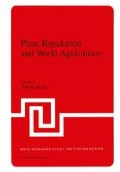Abstract
A plant, unlike an animal, has to grow and survive and yet remain in the same place throughout its life. Furthermore, it is exposed to attack by pests and diseases, competition from weeds, and may be subjected to various forms of environmental stress. In man’s attempts to help crop plants achieve their full potential, methods have been developed to control pests, diseases, and weeds; the plant breeder has produced improved varieties; and better performance is sometimes achieved by manipulating the crop by such devices as grafting and pruning. Better yields can be ensured by a balanced fertilizer program and unsuitable soil conditions can be improved by drainage or irrigation. Except in special situations, however, such as in glasshouses, it is not possible to control the weather—the main environmental factor which affects plant growth and development.
Access this chapter
Tax calculation will be finalised at checkout
Purchases are for personal use only
Preview
Unable to display preview. Download preview PDF.
References
Bailey, J. A., Carter, G. A., Burden, R. S., and Wain, R. L., 1975, Control of rust diseases by diterpenes from Nicotiana glutinosa, Nature (London), 255:328–329.
Brian, P. W., 1949, Studies on the biological activity of griseofulvin, Ann. Bot., 13:59–77.
Chamberlain, V. K., Chamberlain, K., and Wain, R. L., 1976, Studies on plant growth-regulating substances. XXXIX. The plant growth-retarding properties of certain quaternary ammonium halides, Ann. Appl. Biol., 82:589–596.
Hiron, R. W. P., and Wright, S. T. C., 1973, The role of endogenous abscisic acid in the response of plants to stress, J. Exp. Bot., 24:769–780.
Jones, R. J., and Mansfield, T. A., 1970, Suppression of stomatic opening in leaves treated with abscisic acid, J. Exp. Bot., 21:714–719.
Knight, B. E. A., Taylor, H. F., and Wain, R. L., 1969, Studies on plant growth-regulating substances. XXIX. The plant growth-retarding properties of certain ammonium, phosphorium and sulphonium halides, Ann. Appl. Biol., 63:211–223.
Kögl, F., Haagen-Smit, A. J., and Erxleben, H., 1934, Über ein neues Auxin (“Heteroauxin”) aus Harn. XI. Mitteilung über pflanzenliche Wachstumstoffe, Z. physiol. Chemie, 228:90–103.
Larqué-Saavedra, A., and Wain, R. L., 1974, Abscisic acid levels in relation to drought tolerance in varieties of Zea mays L., Nature (London), 251:716–717.
Larqué-Saavedra, A., and Wain, R. L., 1976, Studies on plant growth-regulating substances. XLII. Abscisic acid as a genetic character related to drought tolerance, Ann. Appl. Biol., 83: 291–297.
Nash, R. J., Smith, T. A., and Wain, R. L., 1968, Studies on plant growth-regulating substances. XXVII. The growth-regulating activity and metabolism of 2,4-dichlorophenoxyethylamine and related compounds in higher plants, Ann. Appl. Biol., 61:481–494.
Robert, M. L., Taylor, H. F., and Wain, R. L., 1975, Ethylene production by cress roots and excised cress root segments and its inhibition by 3,5-diiodo-4-hydroxybenzoic acid, Planta, 126:273–284.
Smith, M. S., and Moshin, M., 1970, 3,5 dichlorophenoxyacetic acid as a growth retardant, Ann. Appl. Biol., 66:233–238.
Taylor, H. F., and Wain, R. L., 1978, Studies on plant growth-regulating substances. LII. Growth retardation by 3,5 dichlorophenoxyethylamine and 3,5 dichlorophenoxybutyric acid arising from their conversion to 3,5 dichlorophenoxyacetic acid from tomato plants, Ann. Appl. Biol., 89:271–275.
Wain, R. L. , 1955a, A new approach to selective weed controls, Ann. Appl. Biol., 42:151–157.
Wain, R. L., 1955b, Herbicidal selectivity through specific action of plants on compounds applied, J. Agric. Food Chem., 3:128–130.
Wain, R. L., 1963, 3:5-dihalogeno-4-hydroxybenzonitriles as herbicides, Nature (London), 200:28.
Wain, R. L., Taylor, H. F., Intarakosit, P., and Shannon, T. G. D., 1968, Halogen derivatives of 4-hydroxybenzoic acid as root growth stimulants and the importance of light to this response, Nature (London), 217:870–871.
Wain, R. L. , 1977, Chemical aspects of plant disease resistance, Pontif. Acad. Sci. Scr. Varia, 41:483–508.
Wain, R. L. , and Wightman, F., 1957, Studies on plant growth-regulating substances. XI. Auxin antagonism in relation to a theory on mode of action of aryl- and aryloxy-alkanecarboxylic acids, Ann. Appl. Biol., 45:140–157.
Wilcox, E. J. , and Wain, R. L., 1976, Studies on plant growth-regulating substances. XLIV. The cytokinin activity of 6-benzyloxypurine, Ann. Appl. Biol., 84:403–407.
Wilkins, H., Burden, R. S., and Wain, R. L., 1974, Growth inhibitors in roots of light- and dark-grown seedlings of Zea mays, Ann. Appl. Biol., 78:337–338.
Wilkins, H. , Larqué-Saavedra, A., and Wain, R. L. , 1973, “Plant Growth Substances,” Tokyo, Hirowaka Publ. Co.
Wilkins, H. , and Wain, R. L. , 1975, The role of root cap in the response of the primary roots of Zea mays L. seedlings to white light and to gravity, Planta, 123:217–222.
Wilkins, S. M., Wilkins, H., and Wain, R. L., 1976, Chemical treatment of soil alleviate effects of soil compaction on pea seedling growth, Nature (London), 259:392–394.
Wright, S. T. C., 1969, An increase in the “Inhibitor-β” content of detached wheat leaves following a period of wilting, Planta, 86:10–20.
Wright, S. T. C., and Hiron, R. W. P., 1969, (+) — Abscisic acid, the growth inhibitor induced in detached wheat leaves by a period of wilting, Nature (London), 224:719–720.
Author information
Authors and Affiliations
Editor information
Editors and Affiliations
Rights and permissions
Copyright information
© 1979 Plenum Press, New York
About this chapter
Cite this chapter
Wain, R.L. (1979). Potential for Regulation of Plant Growth and Development. In: Scott, T.K. (eds) Plant Regulation and World Agriculture. Nato Advanced Study Institutes Series, vol 22. Springer, Boston, MA. https://doi.org/10.1007/978-1-4684-3512-2_10
Download citation
DOI: https://doi.org/10.1007/978-1-4684-3512-2_10
Publisher Name: Springer, Boston, MA
Print ISBN: 978-1-4684-3514-6
Online ISBN: 978-1-4684-3512-2
eBook Packages: Springer Book Archive

